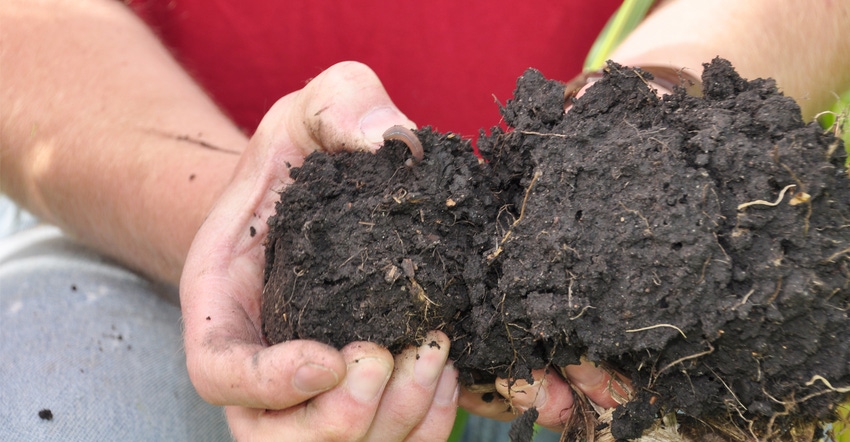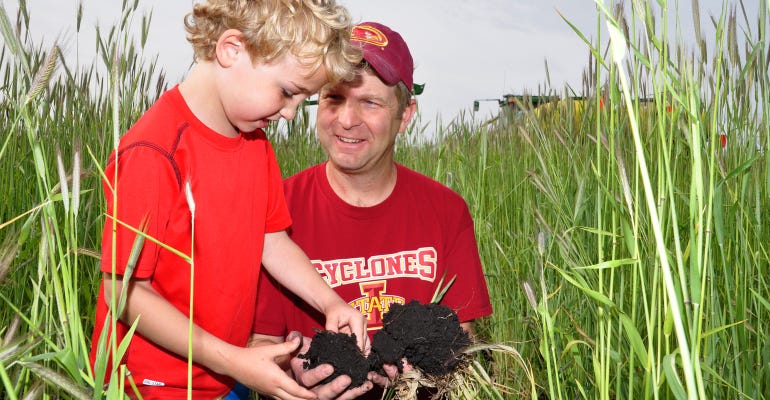May 30, 2019

Saturated fields are a frustration to farmers trying to complete planting corn and soybeans. Soil conservation experts are urging farmers to take a close look at tillage practices, which can make a difference in a spring like 2019’s.
Farmers using a no-till or strip-till system have generally been able to get into fields quicker than conventionally tilled fields, says Doug Adams, a farmer who works as a soil conservation technician in the Humboldt County field office of USDA’s Natural Resources Conservation Service in northern Iowa.
Last fall was one of the wettest on record for Iowa, and rains continued this spring. It’s been an eye-opening year for farmers who have a no-till system in place.
Cover crops helpful
“Of course, there are still limits,” Adams says. “We can’t access fields that are totally saturated, as water lubricates soil particles, and you can still cause compaction. But once you get the soil structure built up with no-till or strip till, the internal drainage is improved. Cover crops used in conjunction with no-till or strip till provide even more soil structure benefits.”
In his farming operation, Adams seeds a cereal rye cover crop on all acres in the fall. Come spring, he prefers to not terminate the cover crop too early. The rye helps dry the soil, which is a boon in a wet spring. Growing and pulling moisture from the soil, the rye is especially beneficial where no tile drainage exists.
“Terminating the rye cover at planting time allows us to pull as much moisture out of the ground as we can before we plant,” he says. “As the rye cover crop dies, falls down and mulches the soil, it’ll keep the ground moist and cooler during summer when we need the moisture.”
Terminating a cover crop
“I evaluate the stand of cereal rye. If it’s a good, thick stand and growing tall, say above knee high to waist high, I’ll usually spray just glyphosate to terminate,” Adams says. “If it’s a spotty stand, I’ll add a preemergence herbicide to the glyphosate.”

LESSONS LEARNED: Doug Adams with son Tyler examines the changes in the structure of the soil.

For soybeans, he’s been using Enlite as the preemergence herbicide in the Roundup burndown mix. The preemergence herbicide helps hold back waterhemp later on in the growing season, if there’s not enough of the killed rye mat covering the ground to hold back the weeds.
“Because we sometimes seed the rye aerially, we might have spots in a field that didn’t get much rye on them,” Adams says. “Weeds will break through there. If we’ve got that type of stand, I like to use a preemergence herbicide with my burndown.”
When talking to farmers about soil structure and soil biology, Adams emphasizes that soil improvement begins the day they quit tilling. “It takes three to five years from the point a farmer stops tilling before they will see a noticeable difference in soil structure and biological activity, although adding cover crops can cut that window in half,” he says. “If you run a tillage tool through the field, you set the clock back to day one.”
Improving soil structure
Adding acres to his farming operation presents new challenges but reinforces his belief that no-till or strip till with cover crops is the right way to go. “In my experience, switching to no-till and strip-till farming doesn’t result in a yield drop, and you see soil health and water quality benefits pretty quickly,” Adams says.
In 2019, he added a piece of land directly across the road from another field he farms. The previous farmer completed the fall tillage work, and Adams planted it to corn this spring. “When I walk into this tilled field, I pick up a lot of mud on my boots,” he says. “But when I walk into the no-till soil across the road, I don’t sink in. This reinforces to me that going no-till improves water infiltration. The deeper we can get water to go into the soil profile, the better off we are later in the season if the weather turns hot and dry. This helps stabilize my yields over the long haul.”
The most visible change in soil health is noticed in the feel of the soil. “As their cover crops are growing in the spring, we dig the soil and show farmers how they can tell by looking at it and feeling it. The cover crop soil has an improved structure,” Adams says.
Also, to foster soil health along with farming profitability in conservation systems, Adams is a believer in the 4R system of nutrient management: applying the right source, at the right rate, at the right time and in the right place. For information, visit 4rplus.org.
About the Author(s)
You May Also Like






